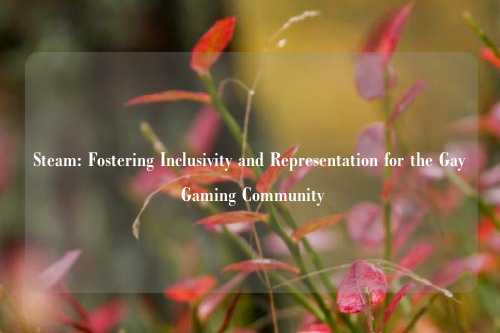Introduction
The gaming industry has evolved significantly over the past few decades, not only in terms of technology but also in terms of representation and inclusivity. One of the most prominent platforms in PC gaming, Steam, has played a crucial role in fostering a diverse and welcoming environment for gamers of all backgrounds, including the LGBTQ+ community. This article explores the intersection of Steam and gay gaming culture, examining how the platform supports queer developers, promotes LGBTQ+ representation in games, and provides a space for gay gamers to connect and thrive.
Steam as a Hub for LGBTQ+ Games
Steam, developed by Valve Corporation, is the largest digital distribution platform for PC gaming, boasting millions of active users and thousands of games. Over the years, it has become a vital marketplace for indie developers, many of whom create games with LGBTQ+ themes. Titles such as Dream Daddy: A Dad Dating Simulator, Coming Out on Top, and Butterfly Soup have found success on Steam, offering narratives that center on gay and queer experiences.

Unlike traditional gaming marketplaces, Steam’s open submission policy allows smaller developers to publish their work without the gatekeeping often seen in mainstream gaming. This has led to a surge in queer storytelling in video games, where gay characters are not just side roles but protagonists with fully fleshed-out stories.
Visibility and Curation: Steam’s Role in Promoting Gay Content
One of Steam’s strengths is its tagging and recommendation system, which helps players discover games that align with their interests. Tags such as "LGBTQ+", "Gay Protagonist", and "Romance" make it easier for gay gamers to find titles that resonate with them. Additionally, Steam has featured LGBTQ+ games in special sales and events, such as Pride Month celebrations, further increasing their visibility.
However, the platform has not been without controversy. Some developers have criticized Steam for inconsistent moderation, where games with queer themes sometimes face unfair censorship or backlash from certain segments of the gaming community. Despite this, Steam has generally maintained a stance of inclusivity, allowing LGBTQ+ games to flourish alongside mainstream titles.
Community and Social Features: Connecting Gay Gamers
Beyond just selling games, Steam provides social features that help gay gamers connect. The Steam Community allows users to join groups, participate in discussions, and share content. Many LGBTQ+ gaming groups exist on Steam, offering safe spaces for queer players to discuss games, share recommendations, and even organize multiplayer sessions.
Steam’s profile customization options also enable users to express their identities. Players can display LGBTQ+ pride badges, use rainbow-themed profile backgrounds, and showcase their favorite queer games in their libraries. These features contribute to a sense of belonging for gay gamers who may feel marginalized in other gaming spaces.
Challenges and Criticisms
While Steam has been a positive force for LGBTQ+ representation, challenges remain. Some gay-themed games face review bombing—where users leave negative reviews not based on gameplay quality but due to prejudice. Valve has taken steps to combat this by hiding off-topic reviews, but the issue persists.
Another concern is the lack of major AAA games with prominent gay protagonists on Steam. While indie developers have led the charge in queer representation, larger studios have been slower to adopt inclusive storytelling. Steam’s marketplace reflects this disparity, with most LGBTQ+ narratives coming from smaller, independent creators.
The Future of Gay Gaming on Steam
The future looks promising for gay gaming on Steam. As the platform continues to grow, so does the demand for diverse narratives. More developers are creating games with queer themes, and Steam’s algorithms are improving in recommending these titles to interested players.
Additionally, Valve has shown willingness to support LGBTQ+ initiatives, such as hosting charity events for queer organizations and featuring Pride-themed content. If this trend continues, Steam will remain a leading platform for gay gamers and developers alike.
Conclusion
Steam has become an essential platform for the gay gaming community, offering a space where queer narratives can thrive and where LGBTQ+ players can find representation and community. While challenges like censorship and review bombing persist, the platform’s commitment to inclusivity and its support for indie developers make it a vital part of the gaming landscape.
As the industry continues to evolve, Steam’s role in promoting LGBTQ+ visibility will likely expand, ensuring that gay gamers have access to stories that reflect their experiences. Whether through indie gems like Hades (which features a bisexual protagonist) or upcoming titles with queer themes, Steam remains a beacon of diversity and acceptance in gaming.
For gay gamers, Steam is more than just a store—it’s a home.